Appendix A to Part 1022 [Reserved]
12:8.0.2.1.18.15.1.1.35 : Appendix A
Appendix A to Part 1022 [Reserved]
Appendix B to Part 1022 - Model Notices of Furnishing Negative Information
12:8.0.2.1.18.15.1.1.36 : Appendix B
Appendix B to Part 1022 - Model Notices of Furnishing Negative
Information
a. Although use of the model notices is not required, a
financial institution that is subject to section 623(a)(7) of the
FCRA shall be deemed to be in compliance with the notice
requirement in section 623(a)(7) of the FCRA if the institution
properly uses the model notices in this appendix (as
applicable).
b. A financial institution may use Model Notice B-1 if the
institution provides the notice prior to furnishing negative
information to a nationwide consumer reporting agency.
c. A financial institution may use Model Notice B-2 if the
institution provides the notice after furnishing negative
information to a nationwide consumer reporting agency.
d. Financial institutions may make certain changes to the
language or format of the model notices without losing the safe
harbor from liability provided by the model notices. The changes to
the model notices may not be so extensive as to affect the
substance, clarity, or meaningful sequence of the language in the
model notices. Financial institutions making such extensive
revisions will lose the safe harbor from liability that this
appendix provides. Acceptable changes include, for example,
1. Rearranging the order of the references to “late payment(s),”
or “missed payment(s).”
2. Pluralizing the terms “credit bureau,” “credit report,” and
“account.”
3. Specifying the particular type of account on which
information may be furnished, such as “credit card account.”
4. Rearranging in Model Notice B-1 the phrases “information
about your account” and “to credit bureaus” such that it would read
“We may report to credit bureaus information about your
account.”
Model Notice B-1
We may report information about your account to credit bureaus.
Late payments, missed payments, or other defaults on your account
may be reflected in your credit report.
Model Notice B-2
We have told a credit bureau about a late payment, missed
payment or other default on your account. This information may be
reflected in your credit report.
Appendix C to Part 1022 - Model Forms for Opt-Out Notices
12:8.0.2.1.18.15.1.1.37 : Appendix C
Appendix C to Part 1022 - Model Forms for Opt-Out Notices
a. Although use of the model forms is not required, use of the
model forms in this appendix (as applicable) complies with the
requirement in section 624 of the Act for clear, conspicuous, and
concise notices.
b. Certain changes may be made to the language or format of the
model forms without losing the protection from liability afforded
by use of the model forms. These changes may not be so extensive as
to affect the substance, clarity, or meaningful sequence of the
language in the model forms. Persons making such extensive
revisions will lose the safe harbor that this appendix provides.
Acceptable changes include, for example:
1. Rearranging the order of the references to “your income,”
“your account history,” and “your credit score.”
2. Substituting other types of information for “income,”
“account history,” or “credit score” for accuracy, such as “payment
history,” “credit history,” “payoff status,” or “claims
history.”
3. Substituting a clearer and more accurate description of the
affiliates providing or covered by the notice for phrases such as
“the [ABC] group of companies,” including without limitation a
statement that the entity providing the notice recently purchased
the consumer's account.
4. Substituting other types of affiliates covered by the notice
for “credit card,” “insurance,” or “securities” affiliates.
5. Omitting items that are not accurate or applicable. For
example, if a person does not limit the duration of the opt-out
period, the notice may omit information about the renewal
notice.
6. Adding a statement informing consumers how much time they
have to opt out before shared eligibility information may be used
to make solicitations to them.
7. Adding a statement that the consumer may exercise the right
to opt out at any time.
8. Adding the following statement, if accurate: “If you
previously opted out, you do not need to do so again.”
9. Providing a place on the form for the consumer to fill in
identifying information, such as his or her name and address.
10. Adding disclosures regarding the treatment of opt-outs by
joint consumers to comply with § 1022.23(a)(2) of this part.
C-1 Model Form for Initial Opt-out Notice (Single-Affiliate Notice)
C-2 Model Form for Initial Opt-out Notice (Joint Notice) C-3 Model
Form for Renewal Notice (Single-Affiliate Notice) C-4 Model Form
for Renewal Notice (Joint Notice) C-5 Model Form for Voluntary “No
Marketing” Notice C-1 - Model Form for Initial Opt-Out Notice
(Single-Affiliate Notice) - [Your Choice To Limit
Marketing]/[Marketing Opt-Out]
• [Name of Affiliate] is providing this notice.
• [Optional: Federal law gives you the right to limit some but
not all marketing from our affiliates. Federal law also requires us
to give you this notice to tell you about your choice to limit
marketing from our affiliates.]
• You may limit our affiliates in the [ABC] group of companies,
such as our [credit card, insurance, and securities] affiliates,
from marketing their products or services to you based on your
personal information that we collect and share with them. This
information includes your [income], your [account history with us],
and your [credit score].
• Your choice to limit marketing offers from our affiliates will
apply [until you tell us to change your choice]/[for x years from
when you tell us your choice]/[for at least 5 years from when you
tell us your choice]. [Include if the opt-out period expires.] Once
that period expires, you will receive a renewal notice that will
allow you to continue to limit marketing offers from our affiliates
for [another x years]/[at least another 5 years].
• [Include, if applicable, in a subsequent notice, including an
annual notice, for consumers who may have previously opted out.] If
you have already made a choice to limit marketing offers from our
affiliates, you do not need to act again until you receive the
renewal notice.
To limit marketing offers, contact us [include all that
apply]:
• By telephone: 1-(877) ###-#### • On the Web:
www. - .com •
By mail: Check the box and complete the form below, and send the
form to:
[Company name]
[Company address]
- Do not allow your affiliates to use my personal information to
market to me.
C-2 - Model Form for Initial Opt-Out Notice (Joint Notice) - [Your
Choice To Limit Marketing]/[Marketing Opt-Out]
• The [ABC group of companies] is providing this notice.
• [Optional: Federal law gives you the right to limit some but
not all marketing from the [ABC] companies. Federal law also
requires us to give you this notice to tell you about your choice
to limit marketing from the [ABC] companies.]
• You may limit the [ABC] companies, such as the [ABC credit
card, insurance, and securities] affiliates, from marketing their
products or services to you based on your personal information that
they receive from other [ABC] companies. This information includes
your [income], your [account history], and your [credit score].
• Your choice to limit marketing offers from the [ABC] companies
will apply [until you tell us to change your choice]/[for x years
from when you tell us your choice]/[for at least 5 years from when
you tell us your choice]. [Include if the opt-out period expires.]
Once that period expires, you will receive a renewal notice that
will allow you to continue to limit marketing offers from the [ABC]
companies for [another x years]/[at least another 5 years].
• [Include, if applicable, in a subsequent notice, including an
annual notice, for consumers who may have previously opted out.] If
you have already made a choice to limit marketing offers from the
[ABC] companies, you do not need to act again until you receive the
renewal notice.
To limit marketing offers, contact us [include all that
apply]:
• By telephone: 1-(877) ###-#### • On the Web:
www. - .com •
By mail: Check the box and complete the form below, and send the
form to:
[Company name]
[Company address]
- Do not allow any company [in the ABC group of companies] to
use my personal information to market to me.
C-3 - Model Form for Renewal Notice (Single-Affiliate Notice) -
[Renewing Your Choice To Limit Marketing]/[Renewing Your Marketing
Opt-Out]
• [Name of Affiliate] is providing this notice.
• [Optional: Federal law gives you the right to limit some but
not all marketing from our affiliates. Federal law also requires us
to give you this notice to tell you about your choice to limit
marketing from our affiliates.]
• You previously chose to limit our affiliates in the [ABC]
group of companies, such as our [credit card, insurance, and
securities] affiliates, from marketing their products or services
to you based on your personal information that we share with them.
This information includes your [income], your [account history with
us], and your [credit score].
• Your choice has expired or is about to expire.
To renew your choice to limit marketing for [x] more years,
contact us [include all that apply]:
• By telephone: 1-(877) ###-#### • On the Web:
www. - .com •
By mail: Check the box and complete the form below, and send the
form to:
[Company name]
[Company address]
- Renew my choice to limit marketing for [x] more years.
C-4 - Model Form for Renewal Notice (Joint Notice) - [Renewing Your
Choice To Limit Marketing]/[Renewing Your Marketing Opt-Out]
• The [ABC group of companies] is providing this notice.
• [Optional: Federal law gives you the right to limit some but
not all marketing from the [ABC] companies. Federal law also
requires us to give you this notice to tell you about your choice
to limit marketing from the [ABC] companies.]
• You previously chose to limit the [ABC] companies, such as the
[ABC credit card, insurance, and securities] affiliates, from
marketing their products or services to you based on your personal
information that they receive from other ABC companies. This
information includes your [income], your [account history], and
your [credit score].
• Your choice has expired or is about to expire.
To renew your choice to limit marketing for [x] more years,
contact us [include all that apply]:
• By telephone: 1-(877) ###-#### • On the Web:
www. - .com •
By mail: Check the box and complete the form below, and send the
form to:
[Company name]
[Company address]
- Renew my choice to limit marketing for [x] more years. C-5 -
Model Form for Voluntary “No Marketing” Notice - [Your Choice To
Stop Marketing]
• [Name of Affiliate] is providing this notice.
• You may choose to stop all marketing from us and our
affiliates.
• [Your choice to stop marketing from us and our affiliates will
apply until you tell us to change your choice.]
To stop all marketing, contact us [include all that apply]:
• By telephone: 1 (877) ###-#### • On the Web:
www. - .com •
By mail: Check the box and complete the form below, and send the
form to:
[Company name]
[Company address]
- Do not market to me.
Appendix D to Part 1022 - Model Forms for Firm Offers of Credit or Insurance
12:8.0.2.1.18.15.1.1.38 : Appendix D
Appendix D to Part 1022 - Model Forms for Firm Offers of Credit or
Insurance
In order to comply with § 1022.54, the following model notices
may be used:
(a) English language model notice - (1) Short
notice.
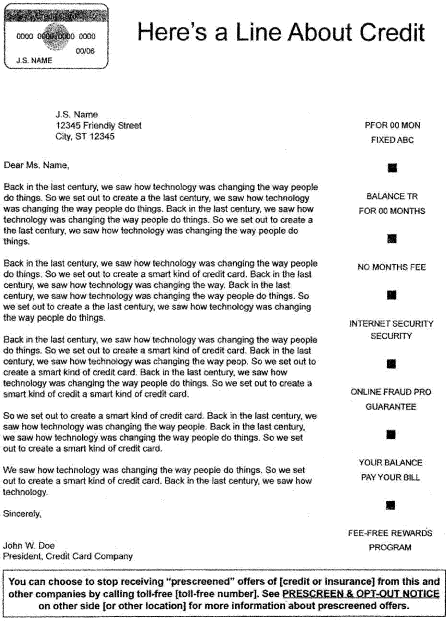
(2) Long notice.

(b) Spanish language model notice - (1) Short
notice.
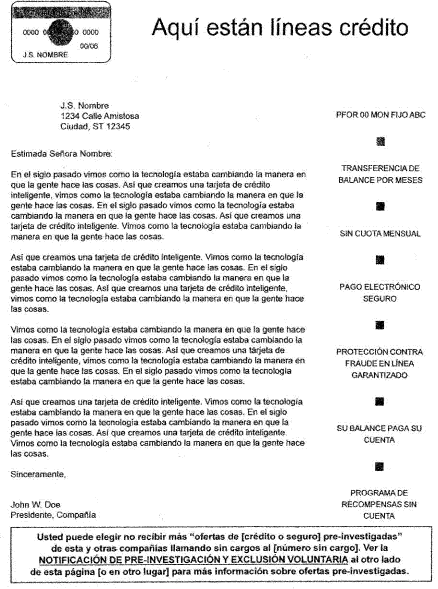
(2) Long notice.
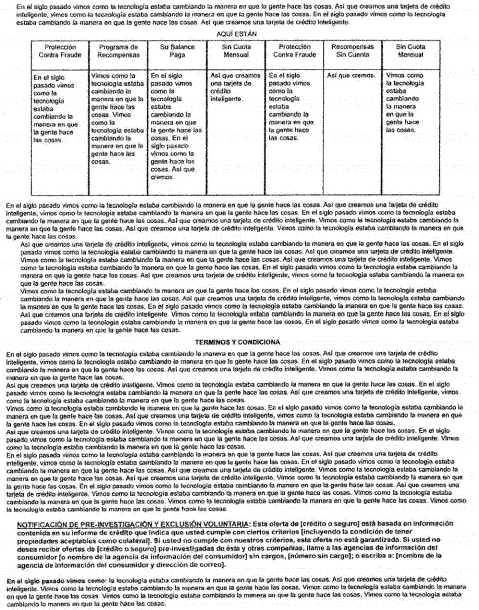
Appendix E to Part 1022 - Interagency Guidelines Concerning the Accuracy and Integrity of Information Furnished to Consumer Reporting Agencies
12:8.0.2.1.18.15.1.1.39 : Appendix E
Appendix E to Part 1022 - Interagency Guidelines Concerning the
Accuracy and Integrity of Information Furnished to Consumer
Reporting Agencies
The Bureau encourages voluntary furnishing of information to
consumer reporting agencies. Section 1022.42 of this part requires
each furnisher to establish and implement reasonable written
policies and procedures concerning the accuracy and integrity of
the information it furnishes to consumer reporting agencies. Under
§ 1022.42(b) of this part, a furnisher must consider the guidelines
set forth below in developing its policies and procedures. In
establishing these policies and procedures, a furnisher may include
any of its existing policies and procedures that are relevant and
appropriate. Section 1022.42(c) requires each furnisher to review
its policies and procedures periodically and update them as
necessary to ensure their continued effectiveness.
I. Nature, Scope, and Objectives of Policies and Procedures
(a) Nature and Scope. Section 1022.42(a) of this part
requires that a furnisher's policies and procedures be appropriate
to the nature, size, complexity, and scope of the furnisher's
activities. In developing its policies and procedures, a furnisher
should consider, for example:
(1) The types of business activities in which the furnisher
engages;
(2) The nature and frequency of the information the furnisher
provides to consumer reporting agencies; and
(3) The technology used by the furnisher to furnish information
to consumer reporting agencies.
(b) Objectives. A furnisher's policies and procedures
should be reasonably designed to promote the following
objectives:
(1) To furnish information about accounts or other relationships
with a consumer that is accurate, such that the furnished
information:
(i) Identifies the appropriate consumer;
(ii) Reflects the terms of and liability for those accounts or
other relationships; and
(iii) Reflects the consumer's performance and other conduct with
respect to the account or other relationship;
(2) To furnish information about accounts or other relationships
with a consumer that has integrity, such that the furnished
information:
(i) Is substantiated by the furnisher's records at the time it
is furnished;
(ii) Is furnished in a form and manner that is designed to
minimize the likelihood that the information may be incorrectly
reflected in a consumer report; thus, the furnished information
should:
(A) Include appropriate identifying information about the
consumer to whom it pertains; and
(B) Be furnished in a standardized and clearly understandable
form and manner and with a date specifying the time period to which
the information pertains; and
(iii) Includes the credit limit, if applicable and in the
furnisher's possession;
(3) To conduct reasonable investigations of consumer disputes
and take appropriate actions based on the outcome of such
investigations; and
(4) To update the information it furnishes as necessary to
reflect the current status of the consumer's account or other
relationship, including, for example:
(i) Any transfer of an account (e.g., by sale or
assignment for collection) to a third party; and
(ii) Any cure of the consumer's failure to abide by the terms of
the account or other relationship.
II. Establishing and Implementing Policies and Procedures
In establishing and implementing its policies and procedures, a
furnisher should:
(a) Identify practices or activities of the furnisher that can
compromise the accuracy or integrity of information furnished to
consumer reporting agencies, such as by:
(1) Reviewing its existing practices and activities, including
the technological means and other methods it uses to furnish
information to consumer reporting agencies and the frequency and
timing of its furnishing of information;
(2) Reviewing its historical records relating to accuracy or
integrity or to disputes; reviewing other information relating to
the accuracy or integrity of information provided by the furnisher
to consumer reporting agencies; and considering the types of
errors, omissions, or other problems that may have affected the
accuracy or integrity of information it has furnished about
consumers to consumer reporting agencies;
(3) Considering any feedback received from consumer reporting
agencies, consumers, or other appropriate parties;
(4) Obtaining feedback from the furnisher's staff; and
(5) Considering the potential impact of the furnisher's policies
and procedures on consumers.
(b) Evaluate the effectiveness of existing policies and
procedures of the furnisher regarding the accuracy and integrity of
information furnished to consumer reporting agencies; consider
whether new, additional, or different policies and procedures are
necessary; and consider whether implementation of existing policies
and procedures should be modified to enhance the accuracy and
integrity of information about consumers furnished to consumer
reporting agencies.
(c) Evaluate the effectiveness of specific methods (including
technological means) the furnisher uses to provide information to
consumer reporting agencies; how those methods may affect the
accuracy and integrity of the information it provides to consumer
reporting agencies; and whether new, additional, or different
methods (including technological means) should be used to provide
information to consumer reporting agencies to enhance the accuracy
and integrity of that information.
III. Specific Components of Policies and Procedures
In developing its policies and procedures, a furnisher should
address the following, as appropriate:
(a) Establishing and implementing a system for furnishing
information about consumers to consumer reporting agencies that is
appropriate to the nature, size, complexity, and scope of the
furnisher's business operations.
(b) Using standard data reporting formats and standard
procedures for compiling and furnishing data, where feasible, such
as the electronic transmission of information about consumers to
consumer reporting agencies.
(c) Maintaining records for a reasonable period of time, not
less than any applicable recordkeeping requirement, in order to
substantiate the accuracy of any information about consumers it
furnishes that is subject to a direct dispute.
(d) Establishing and implementing appropriate internal controls
regarding the accuracy and integrity of information about consumers
furnished to consumer reporting agencies, such as by implementing
standard procedures and verifying random samples of information
provided to consumer reporting agencies.
(e) Training staff that participates in activities related to
the furnishing of information about consumers to consumer reporting
agencies to implement the policies and procedures.
(f) Providing for appropriate and effective oversight of
relevant service providers whose activities may affect the accuracy
or integrity of information about consumers furnished to consumer
reporting agencies to ensure compliance with the policies and
procedures.
(g) Furnishing information about consumers to consumer reporting
agencies following mergers, portfolio acquisitions or sales, or
other acquisitions or transfers of accounts or other obligations in
a manner that prevents re-aging of information, duplicative
reporting, or other problems that may similarly affect the accuracy
or integrity of the information furnished.
(h) Deleting, updating, and correcting information in the
furnisher's records, as appropriate, to avoid furnishing inaccurate
information.
(i) Conducting reasonable investigations of disputes.
(j) Designing technological and other means of communication
with consumer reporting agencies to prevent duplicative reporting
of accounts, erroneous association of information with the wrong
consumer(s), and other occurrences that may compromise the accuracy
or integrity of information provided to consumer reporting
agencies.
(k) Providing consumer reporting agencies with sufficient
identifying information in the furnisher's possession about each
consumer about whom information is furnished to enable the consumer
reporting agency properly to identify the consumer.
(l) Conducting a periodic evaluation of its own practices,
consumer reporting agency practices of which the furnisher is
aware, investigations of disputed information, corrections of
inaccurate information, means of communication, and other factors
that may affect the accuracy or integrity of information furnished
to consumer reporting agencies.
(m) Complying with applicable requirements under the FCRA and
its implementing regulations.
Appendixes F-G to Part 1022 [Reserved]
12:8.0.2.1.18.15.1.1.40 :
Appendixes F-G to Part 1022 [Reserved]
Appendix H to Part 1022 - Model Forms for Risk-Based Pricing and Credit Score Disclosure Exception Notices
12:8.0.2.1.18.15.1.1.41 : Appendix H
Appendix H to Part 1022 - Model Forms for Risk-Based Pricing and
Credit Score Disclosure Exception Notices
1. This appendix contains four model forms for risk-based
pricing notices and three model forms for use in connection with
the credit score disclosure exceptions. Each of the model forms is
designated for use in a particular set of circumstances as
indicated by the title of that model form.
2. Model form H-1 is for use in complying with the general
risk-based pricing notice requirements in Sec. 1022.72 if a credit
score is not used in setting the material terms of credit. Model
form H-2 is for risk-based pricing notices given in connection with
account review if a credit score is not used in increasing the
annual percentage rate. Model form H-3 is for use in connection
with the credit score disclosure exception for loans secured by
residential real property. Model form H-4 is for use in connection
with the credit score disclosure exception for loans that are not
secured by residential real property. Model form H-5 is for use in
connection with the credit score disclosure exception when no
credit score is available for a consumer. Model form H-6 is for use
in complying with the general risk-based pricing notice
requirements in Sec. 1022.72 if a credit score is used in setting
the material terms of credit. Model form H-7 is for risk-based
pricing notices given in connection with account review if a credit
score is used in increasing the annual percentage rate. All forms
contained in this appendix are models; their use is optional.
3. A person may change the forms by rearranging the format or by
making technical modifications to the language of the forms, in
each case without modifying the substance of the disclosures. Any
such rearrangement or modification of the language of the model
forms may not be so extensive as to materially affect the
substance, clarity, comprehensibility, or meaningful sequence of
the forms. Persons making revisions with that effect will lose the
benefit of the safe harbor for appropriate use of appendix H model
forms. A person is not required to conduct consumer testing when
rearranging the format of the model forms.
a. Acceptable changes include, for example:
i. Corrections or updates to telephone numbers, mailing
addresses, or Web site addresses that may change over time.
ii. The addition of graphics or icons, such as the person's
corporate logo.
iii. Alteration of the shading or color contained in the model
forms.
iv. Use of a different form of graphical presentation to depict
the distribution of credit scores.
v. Substitution of the words “credit” and “creditor” or
“finance” and “finance company” for the terms “loan” and
“lender.”
vi. Including pre-printed lists of the sources of consumer
reports or consumer reporting agencies in a “check-the-box”
format.
vii. Including the name of the consumer, transaction
identification numbers, a date, and other information that will
assist in identifying the transaction to which the form
pertains.
viii. Including the name of an agent, such as an auto dealer or
other party, when providing the “Name of the Entity Providing the
Notice.”
ix. Until January 1, 2013, substituting “For more information
about credit reports and your rights under Federal law, visit the
Federal Reserve Board's Web site at www.federalreserve.gov,
or the Federal Trade Commission's Web site at www.ftc.gov.”
for “For more information about credit reports and your rights
under Federal law, visit the Consumer Financial Protection Bureau's
Web site at www.consumerfinance.gov/learnmore.”
b. Unacceptable changes include, for example:
i. Providing model forms on register receipts or interspersed
with other disclosures.
ii. Eliminating empty lines and extra spaces between sentences
within the same section.
4. If a person uses an appropriate appendix H model form, or
modifies a form in accordance with the above instructions, that
person shall be deemed to be acting in compliance with the
provisions of § 1022.73 or § 1022.74, as applicable, of this part.
It is intended that appropriate use of Model Form H-3 also will
comply with the disclosure that may be required under section
609(g) of the FCRA. Optional language in model forms H-6 and H-7
may be used to direct the consumer to the entity (which may be a
consumer reporting agency or the creditor itself, for a proprietary
score that meets the definition of a credit score) that provided
the credit score for any questions about the credit score, along
with the entity's contact information. Creditors may use or not use
the additional language without losing the safe harbor, since the
language is optional.
H-1 Model form for risk-based pricing notice.
H-2 Model form for account review risk-based pricing notice.
H-3 Model form for credit score disclosure exception for credit
secured by one to four units of residential real property.
H-4 Model form for credit score disclosure exception for loans
not secured by residential real property.
H-5 Model form for credit score disclosure exception for loans
where credit score is not available.
H-6 Model form for risk-based pricing notice with credit score
information.
H-7 Model form for account review risk-based pricing notice with
credit score information.

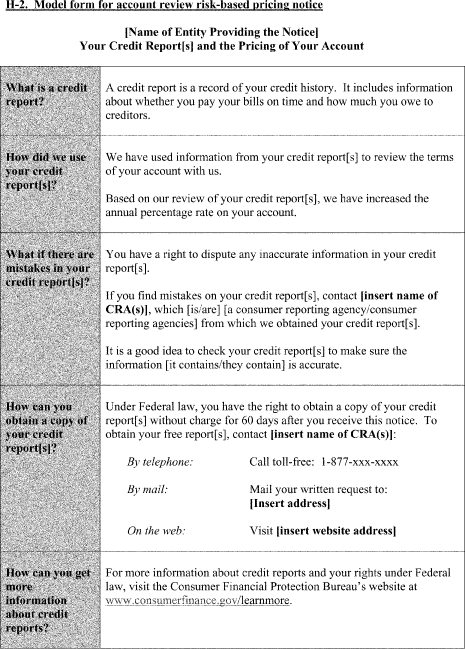
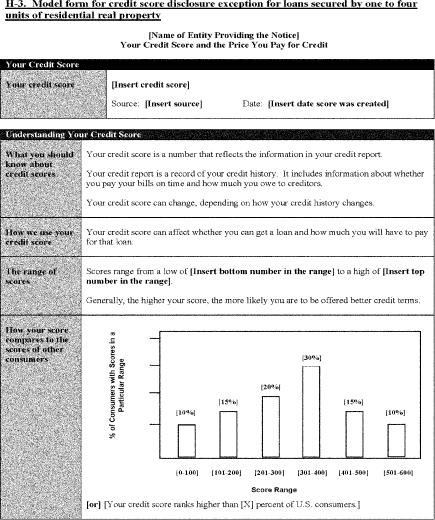
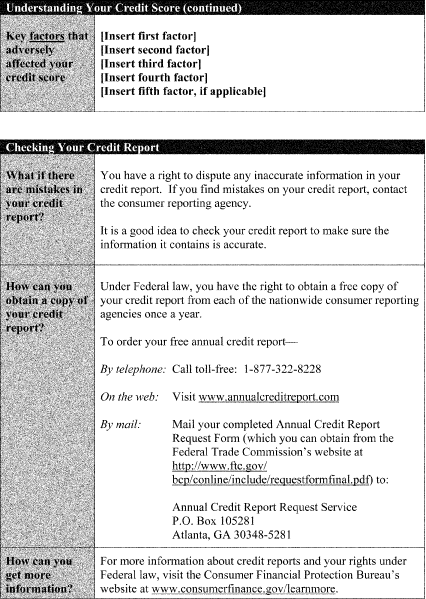
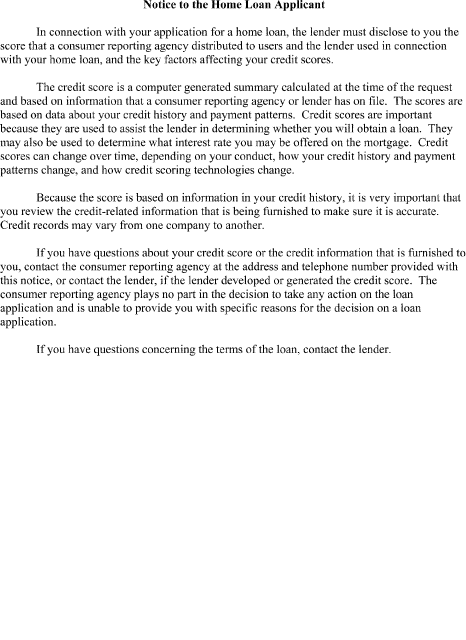
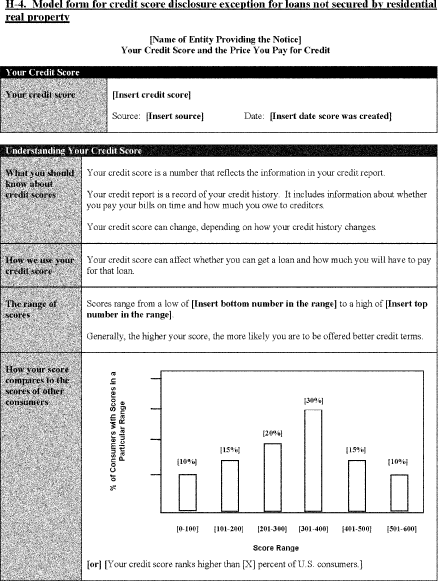
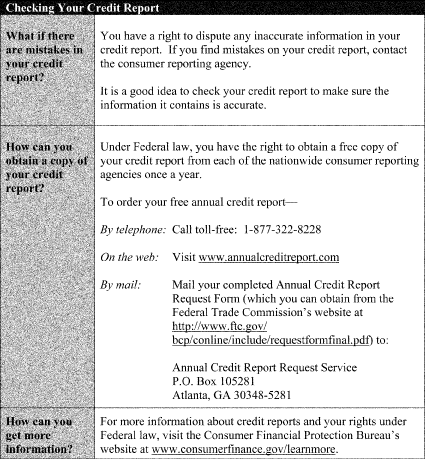

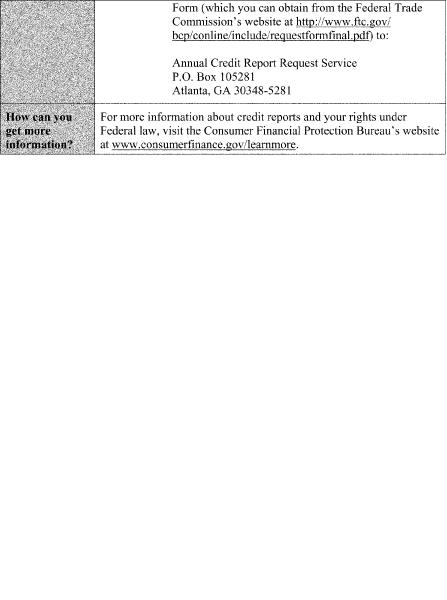
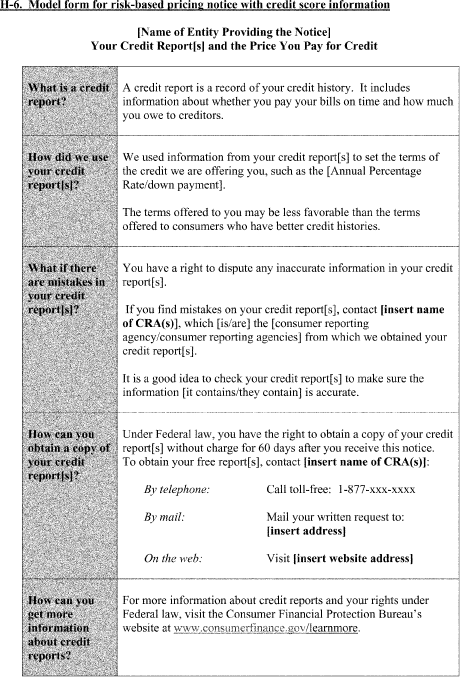

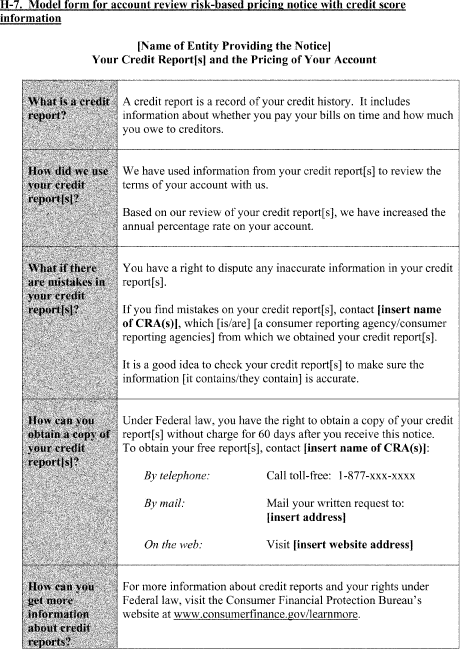

Appendix I to Part 1022 - Summary of Consumer Identity Theft Rights
12:8.0.2.1.18.15.1.1.42 : Appendix I
Appendix I to Part 1022 - Summary of Consumer Identity Theft Rights
The prescribed form for this summary is a disclosure that is
substantially similar to the Bureau's model summary with all
information clearly and prominently displayed. A summary should
accurately reflect changes to those items that may change over time
(such as telephone numbers) to remain in compliance. Translations
of this summary will be in compliance with the Bureau's prescribed
model, provided that the translation is accurate and that it is
provided in a language used by the recipient consumer.

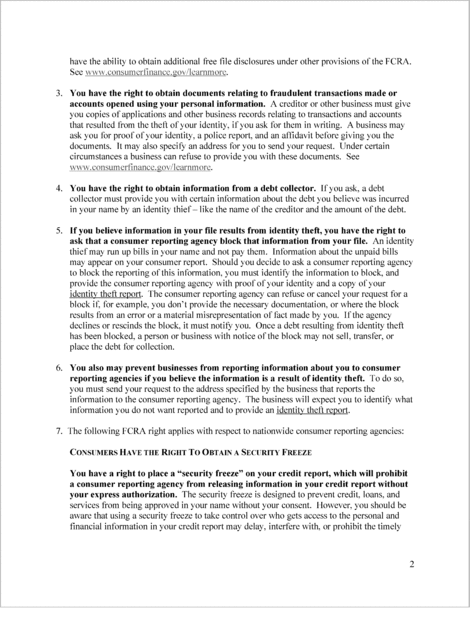

[83 FR 47033,
Sept. 18, 2018]
Appendix J to Part 1022 [Reserved]
12:8.0.2.1.18.15.1.1.43 : Appendix J
Appendix J to Part 1022 [Reserved]
Appendix K to Part 1022 - Summary of Consumer Rights
12:8.0.2.1.18.15.1.1.44 : Appendix K
Appendix K to Part 1022 - Summary of Consumer Rights
The prescribed form for this summary is a disclosure that is
substantially similar to the Bureau's model summary with all
information clearly and prominently displayed. The list of Federal
regulators that is included in the Bureau's prescribed summary may
be provided separately so long as this is done in a clear and
conspicuous way. A summary should accurately reflect changes to
those items that may change over time (e.g., dollar amounts,
or telephone numbers and addresses of Federal agencies) to remain
in compliance. Translations of this summary will be in compliance
with the Bureau's prescribed model, provided that the translation
is accurate and that it is provided in a language used by the
recipient consumer.
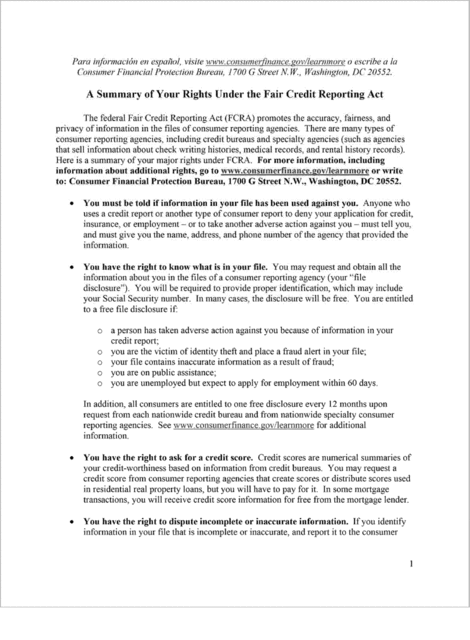
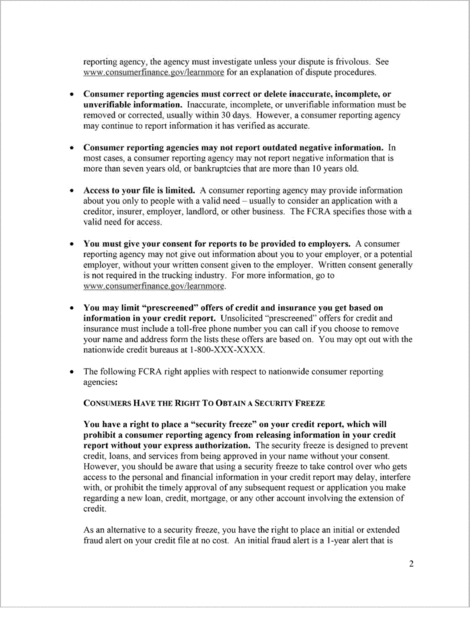
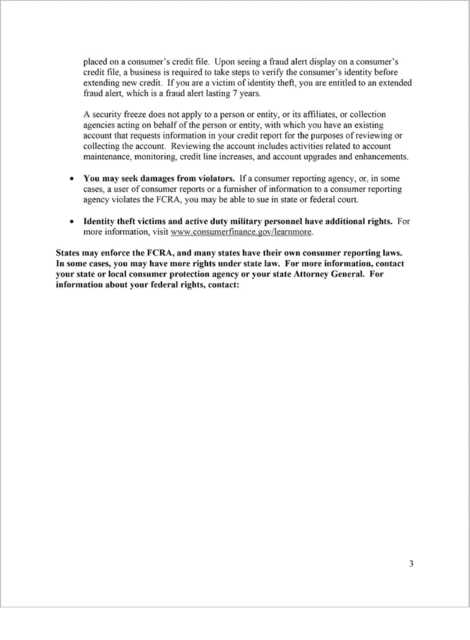
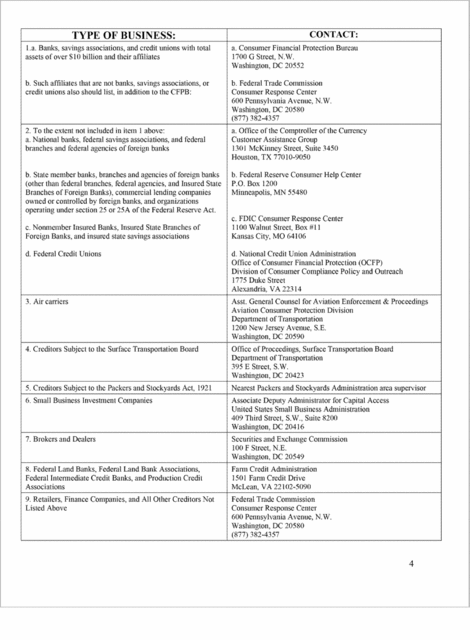
[83 FR 47037,
Sept. 18, 2018]
Appendix L to Part 1022 - Standardized Form for Requesting Annual File Disclosures
12:8.0.2.1.18.15.1.1.45 : Appendix L
Appendix L to Part 1022 - Standardized Form for Requesting Annual
File Disclosures

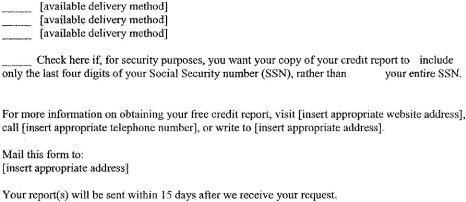
Appendix M to Part 1022 - Notice of Furnisher Responsibilities
12:8.0.2.1.18.15.1.1.46 : Appendix M
Appendix M to Part 1022 - Notice of Furnisher Responsibilities
The prescribed form for this disclosure is a separate document
that is substantially similar to the Bureau's model notice with all
information clearly and prominently displayed. Consumer reporting
agencies may limit the disclosure to only those items that they
know are relevant to the furnisher that will receive the
notice.
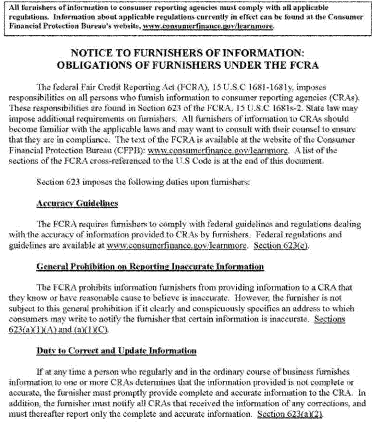
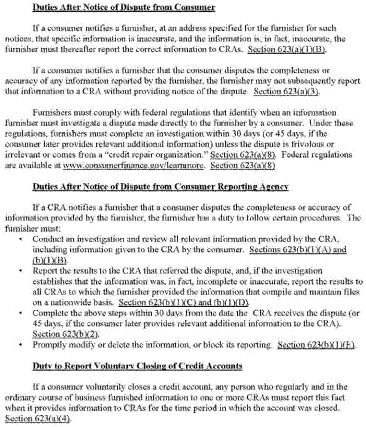

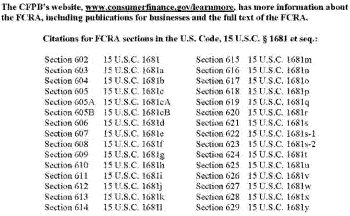
[77 FR 67750, Nov.
14, 2012]
Appendix O to Part 1022 - Reasonable Charges for Certain Disclosures
12:8.0.2.1.18.15.1.1.48 : Appendix O
Appendix O to Part 1022 - Reasonable Charges for Certain
Disclosures
Section 612(f) of the FCRA, 15 U.S.C. 1681j(f), directs the
Bureau to increase the maximum allowable charge a consumer
reporting agency may impose for making a disclosure to the consumer
pursuant to section 609 of the FCRA, 15 U.S.C. 1681g, on January 1
of each year, based proportionally on changes in the Consumer Price
Index, with fractional changes rounded to the nearest fifty cents.
The Bureau will publish notice of the maximum allowable charge each
year by amending this appendix. For calendar year 2021, the maximum
allowable charge is $13.00. For historical purposes:
1. For calendar year 2012, the maximum allowable disclosure
charge was $11.50.
2. For calendar year 2013, the maximum allowable disclosure
charge was $11.50.
3. For calendar year 2014, the maximum allowable disclosure
charge was $11.50.
4. For calendar year 2015, the maximum allowable disclosure
charge was $12.00.
5. For calendar year 2016, the maximum allowable disclosure
charge was $12.00.
6. For calendar year 2017, the maximum allowable disclosure
charge was $12.00.
7. For calendar year 2018, the maximum allowable disclosure
charge was $12.00.
8. For calendar year 2019, the maximum allowable disclosure
charge was $12.50.
9. For calendar year 2020, the maximum allowable disclosure
charge was $12.50.
10. For calendar year 2021, the maximum allowable disclosure
charge is $13.00.
[85 FR 83750, Dec. 23, 2020]